
A drone is a male bee. Unlike the female worker bee, a drone has no stinger. He does not gather nectar or pollen and cannot feed without assistance from worker bees. His only role is to mate with a maiden queen in nuptial flight.

A drone is a male bee. Unlike the female worker bee, a drone has no stinger. He does not gather nectar or pollen and cannot feed without assistance from worker bees. His only role is to mate with a maiden queen in nuptial flight.
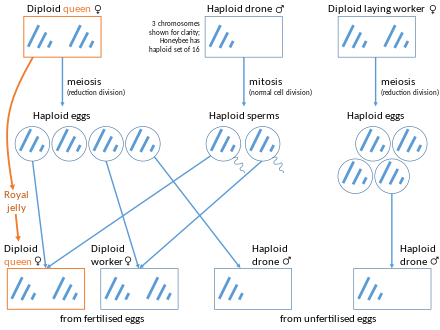
Drones carry only one type of allele at each chromosomal position, because they are haploid (containing only one set of chromosomes from the mother). During the development of eggs within a queen, a diploid cell with 32 chromosomes divides to generate haploid cells called gametes with 16 chromosomes. The result is a haploid egg, with chromosomes having a new combination of alleles at the various loci. This process is called arrhenotokous parthenogenesis or simply arrhenotoky.
Because the male bee technically has only a mother, and no father, its genealogical tree is unusual. The first generation has one member (the male). One generation back also has one member (the mother). Two generations back are two members (the mother and father of the mother). Three generations back are three members. Four back are five members. This sequence – 1, 1, 2, 3, 5, 8, and so on – is the Fibonacci sequence. [1]
Much debate and controversy exists in scientific literature about the dynamics and apparent benefit of the combined forms of reproduction in honey bees and other social insects, known as the haplodiploid sex-determination system. The drones have two reproductive functions: each drone grows from the queen's unfertilized haploid egg and produces some 10 million male sperm cells, each genetically identical to the egg. Drones also serve as a vehicle to mate with a new queen to fertilize her eggs. Female worker bees develop from fertilized eggs and are diploid in origin, which means that the sperm from a father provides a second set of 16 chromosomes for a total of 32: one set from each parent. Since all the sperm cells produced by a particular drone are genetically identical, full sisters are more closely related than full sisters of other animals where the sperm is not genetically identical.
A laying worker bee exclusively produces totally unfertilized eggs, which develop into drones. As an exception to this rule, laying worker bees in some subspecies of honey bees may also produce diploid (and therefore female) fertile offspring in a process called thelytoky, in which the second set of chromosomes comes not from sperm, but from one of the three polar bodies during anaphase II of meiosis.
In honey bees, the genetics of offspring can best be controlled by artificially inseminating (referred to in beekeeping as "instrumental insemination") a queen with drones collected from a single hive, where the drones' mother is known. In the natural mating process, a queen mates with multiple drones, [2] which may not come from the same hive. Therefore, batches of female offspring have fathers of a completely different genetic origin.
A drone is characterized by eyes that are twice the size of those of worker bees and queens, and a body size greater than that of worker bees, though usually smaller than the queen bee. His abdomen is stouter than the abdomen of workers or queen. Although heavy bodied, the drone must be able to fly fast enough to accompany the queen in flight. The average flight time for a drone is about 20 minutes.
An Apis cerana colony has about 200 drones during high summer peak time. Drones depend on worker bees to feed them.
Drones die off or are ejected from the hive by the worker bees in late autumn, dying from exposure and the inability to protect or feed themselves, and do not reappear in the bee hive until late spring. The worker bees evict them as the drones would deplete the hive's resources too quickly if they were allowed to stay. [3]
The drones' main function is to be ready to fertilize a receptive queen. Drones in a hive do not usually mate with a virgin queen of the same hive because the queen flies further to a drone congregation area than the drones do. Mating generally takes place in or near drone congregation areas. How these areas are selected is not understood, but they do exist. When a drone mates with a queen of the same hive, the resultant queen will have a spotty brood pattern (numerous empty cells on a brood frame) due to the removal of diploid drone larvae by nurse bees (i.e., a fertilized egg with two identical sex genes will develop into a drone instead of a worker). The worker bees remove the inbred brood and consume it to recycle the protein.
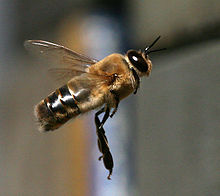
Mating occurs in flight, which accounts for drones needing better vision, which is provided by their large eyes. Should a drone succeed in mating, the first thing that happens is all of the blood in the drone's body rushes to his endophallus, which causes him to lose control over his entire body. His body falls away, leaving a portion of his endophallus attached to the queen which helps guide the next drone in the queen.
Honey bee queen breeders may breed drones to be used for instrumental insemination [4] or open mating. A queen mating yard must have many drones to be successful.
In areas with severe winters, all drones are driven out of the hive in the autumn. A colony begins to rear drones in spring and drone population reaches its peak coinciding with the swarm season in late spring and early summer. The life expectancy of a drone is about 90 days.
Although the drone is highly specialized to perform one function, mating and continuing the propagation of the hive, they may have other purposes. All bees, when they sense the hive's temperature deviating from proper limits, either generate heat by shivering, or exhaust heat by moving air with their wings—behaviours which drones share with worker bees.
Drones do not exhibit typical worker bee behaviors such as nectar and pollen gathering, nursing, or hive construction. While drones are unable to sting, if picked up, they may swing their tails in an attempt to frighten the disturber. [5] In some species, drones buzz around intruders in an attempt to disorient them if the nest is disturbed.
Drones fly in abundance in the early afternoon and are known to congregate in drone congregation areas a good distance away from the hive.
The drone endophallus is optimized to disperse a large quantity of seminal fluid and spermatozoa with great speed and force. The endophallus is held internally in the drone. During mating, the organ is everted (turned inside out), into the queen. The eversion of the endophallus is achieved by contracting abdominal muscles, which increases hemolymph pressure, effectively "inflating" the endophallus. Cornua claspers at the base of the endophallus help to grip the queen.
Mating between a single drone and the queen lasts less than 5 seconds, and it is often completed within 1–2 seconds. Mating occurs mid-flight, and 10–40 m (33–131 ft) above ground. Since the queen mates with 5–19 drones, and drones die after mating, each drone must make the most of his single shot. The drone makes first contact from above the queen, his thorax above her abdomen, straddling her. He then grasps her with all six legs, and everts the endophallus into her opened sting chamber. If the queen's sting chamber is not fully opened, mating is unsuccessful, so some males that mount the queen do not transfer semen. Once the endophallus has been everted, the drone is paralyzed, flipping backwards as he ejaculates. The process of ejaculation is explosive—semen is blasted through the queen's sting chamber and into the oviduct. The process is sometimes audible to the human ear, akin to a "popping" sound. The ejaculation is so powerful that it ruptures the endophallus, disconnecting the drone from the queen. The bulb of the endophallus is broken off inside of the queen during mating—so drones mate only once, and die shortly after. The leftover endophallus remaining in the queen's vagina is referred to as the "mating sign". The plug will not prevent the next drone from mating with the same queen, but may prevent semen from flowing out of the vagina. [6]
Mating between the drones and a virgin queen takes place away from the colony, in mid-air mating sites. These mating sites, called "congregation areas", are specific locations, where drones wait for the arrival of virgin queens. A congregation area is typically 10–40 m (33–131 ft) above ground, and can have a diameter of 30–200 m (98–656 ft). The boundaries of a congregation area are distinct; queens flying a few meters outside the boundaries are mostly ignored by the drones. Congregation areas are typically used year after year, with some spots showing little change over 12 years. Since drones are expelled from a colony during the winter, and new drones are raised each spring, inexperienced drones must find these congregation areas anew. This suggests some environmental cues define a congregation area, although the actual cues are unknown.
Congregation areas are typically located above open ground, away from trees or hills, where flight is somewhat protected from the wind (calm winds may be helpful during mating flight). At the same time, many congregation areas do not show such characteristics, such as those located above water or the forest canopy. Some studies have suggested that magnetic orientation could play a role, since drones older than 6 days contain cells in the abdomen that are rich in magnetite.
Congregation areas can be located by attaching a virgin queen (in a cage) to a balloon floating above ground. The person then moves around, taking note of where drones are attracted to the caged queen. Congregation areas are not found closer than 90 m (300 ft) from an apiary, and congregation areas located farther away from apiaries receive more drones. In a congregation area, drones accumulate from as many as 200 colonies, with estimates of up to 25,000 individual drones. This broad mixing of drones is how a virgin queen can ensure she will receive the genetic diversity needed for her colony. By flying to congregation areas further away from her colony, she further increases the probability of out-breeding.
A single drone visits multiple congregation areas during his lifetime, often taking multiple trips per afternoon. A drone's mating flight averages 20–25 minutes, before he must return to the colony to refuel with honey. While at the site, the drones fly around passively, waiting for the arrival of a virgin. When the virgin queen arrives to the congregation area, the drones locate her by visual and olfactory cues. At this point, it is a race to mate with the virgin queen, to be genetically represented in the newly founded colony. The swarming drones, as they actively follow the queen, reportedly resemble a "drone comet", dissolving and reforming as the drones chase the virgin queen. Drones greatly outnumber the quantity of virgin queens produced per season, so even with multiple mating by the queen, very few drones mate successfully (estimated at less than one in 1,000). If needed, a virgin queen can embark on multiple "nuptial flights", to be sure to receive enough semen from enough drones.

Varroa destructor , a parasitic mite, propagates within the brood cell of bees. The Varroa mite prefers drone brood as it guarantees a longer development period, which is important for its own propagation success. The number of Varroa mites can be kept in check by removing the capped drone brood and either freezing the brood comb or heating it.

A honey bee is a eusocial flying insect within the genus Apis of the bee clade, all native to mainland Afro-Eurasia. After bees spread naturally throughout Africa and Eurasia, humans became responsible for the current cosmopolitan distribution of honey bees, introducing multiple subspecies into South America, North America, and Australia.
Beekeeping is the maintenance of bee colonies, commonly in man-made beehives. Honey bees in the genus Apis are the most commonly kept species but other honey producing bees such as Melipona stingless bees are also kept. Beekeepers keep bees to collect honey and other products of the hive: beeswax, propolis, bee pollen, and royal jelly. Other sources of beekeeping income include pollination of crops, raising queens, and production of package bees for sale. Bee hives are kept in an apiary or "bee yard".

The honey bee life cycle, here referring exclusively to the domesticated Western honey bee, depends greatly on their social structure.

A queen bee is typically an adult, mated female (gyne) that lives in a colony or hive of honey bees. With fully developed reproductive organs, the queen is usually the mother of most, if not all, of the bees in the beehive. Queens are developed from larvae selected by worker bees and specially fed in order to become sexually mature. There is normally only one adult, mated queen in a hive, in which case the bees will usually follow and fiercely protect her.

Varroa destructor, the Varroa mite, is an external parasitic mite that attacks and feeds on honey bees and is one of the most damaging honey bee pests in the world. A significant mite infestation leads to the death of a honey bee colony, usually in the late autumn through early spring. Without management for Varroa mite, honey bee colonies typically collapse within 2 to 3 years in temperate climates. These mites can infest Apis mellifera, the western honey bee, and Apis cerana, the Asian honey bee. Due to very similar physical characteristics, this species was thought to be the closely related Varroa jacobsoni prior to 2000, but they were found to be two separate species after DNA analysis.

The Russian honeybee refers to honey bees that originate in the Primorsky Krai region of Russia. This strain of bee was imported into the United States in 1997 by the USDA Agricultural Research Service's Honeybee Breeding, Genetics & Physiology Laboratory in Baton Rouge, Louisiana, in response to severe declines in bee populations caused by infestations of parasitic mites, and has been used in breeding programs to improve existing stocks. Many Russian queens openly mate with drones from various stock, creating colonies that are genetically hybrid. Some of these 'uncontrolled' hybrids may exhibit "increased aggressiveness, reduced honey production and a decrease in their ability to withstand mites and detrimental expressions of other traits as well."
Hive management in beekeeping refers to intervention techniques that a beekeeper may perform to ensure hive survival and to maximize hive production. Hive management techniques vary widely depending on the objectives.
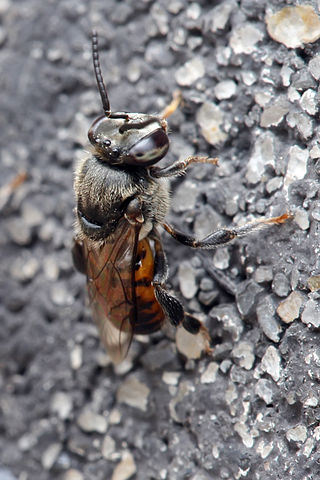
Stingless bees (SB), sometimes called stingless honey bees or simply meliponines, are a large group of bees (from about 462 to 552 described species), comprising the tribe Meliponini (or subtribe Meliponina according to other authors). They belong in the family Apidae (subfamily Apinae), and are closely related to common honey bees (HB, tribe Apini), orchid bees (tribe Euglossini), and bumblebees (tribe Bombini). These four bee tribes belong to the corbiculate bees monophyletic group. Meliponines have stingers, but they are highly reduced and cannot be used for defense, though these bees exhibit other defensive behaviors and mechanisms. Meliponines are not the only type of bee incapable of stinging: all male bees and many female bees of several other families, such as Andrenidae and Megachilidae (tribe Dioxyini), also cannot sting.

The dwarf honey bee, Apis florea, is one of two species of small, wild honey bees of southern and southeastern Asia. It has a much wider distribution than its sister species, Apis andreniformis. First identified in the late 18th century, Apis florea is unique for its morphology, foraging behavior and defensive mechanisms like making a piping noise. Apis florea have open nests and small colonies, which makes them more susceptible to predation than cavity nesters with large numbers of defensive workers. These honey bees are important pollinators and therefore commodified in countries like Cambodia.

Haplodiploidy is a sex-determination system in which males develop from unfertilized eggs and are haploid, and females develop from fertilized eggs and are diploid. Haplodiploidy is sometimes called arrhenotoky.

Apis nigrocincta is a species of honey bee that inhabits the Philippine island of Mindanao as well as the Indonesian islands of Sangihe and Sulawesi. The species is known to have queens with the highest mating frequencies of any species of the tribe Apini.

Bombus ternarius, commonly known as the orange-belted bumblebee or tricolored bumblebee, is a yellow, orange and black bumblebee. It is a ground-nesting social insect whose colony cycle lasts only one season, common throughout the northeastern United States and much of Canada. The orange-belted bumblebee forages on Rubus, goldenrods, Vaccinium, and milkweeds found throughout the colony's range. Like many other members of the genus, Bombus ternarius exhibits complex social structure with a reproductive queen caste and a multitude of sister workers with labor such as foraging, nursing, and nest maintenance divided among the subordinates.

Parthenogenesis is a natural form of asexual reproduction in which growth and development of an embryo can occur directly from an egg without fertilisation. In animals, parthenogenesis means development of an embryo from an unfertilized egg cell. In plants, parthenogenesis is a component process of apomixis. In algae, parthenogenesis can mean the development of an embryo from either an individual sperm or an individual egg.

Nuptial flight is an important phase in the reproduction of most ant, termite, and some bee species. It is also observed in some fly species, such as Rhamphomyia longicauda.

The western honey bee or European honey bee is the most common of the 7–12 species of honey bees worldwide. The genus name Apis is Latin for "bee", and mellifera is the Latin for "honey-bearing" or "honey carrying", referring to the species' production of honey.

Tetragonula carbonaria is a stingless bee, endemic to the north-east coast of Australia. Its common name is sugarbag bee. They are also occasionally referred to as bush bees. The bee is known to pollinate orchid species, such as Dendrobium lichenastrum, D. toressae, and D. speciosum. It has been identified as an insect that collects pollen from the cycad Cycas media. They are also known for their small body size, reduced wing venation, and highly developed social structure comparable to honey bees.

Bombus fervidus, the golden northern bumble bee or yellow bumblebee, is a species of bumblebee native to North America. It has a yellow-colored abdomen and thorax. Its range includes the North American continent, excluding much of the southern United States, Alaska, and the northern parts of Canada. It is common in cities and farmland, with populations concentrated in the Northeastern part of the United States. It is similar in color and range to its sibling species, Bombus californicus, though sometimes also confused with the American bumblebee or black and gold bumblebee. It has complex behavioral traits, which includes a coordinated nest defense to ward off predators. B. fervidus is an important pollinator, so recent population decline is a particular concern.
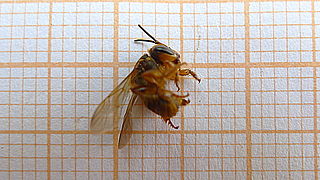
Scaptotrigona postica is a species of stingless bee that lives mainly in Brazil. It is a eusocial bee in the tribe Meliponini. S. postica is one of 25 species in the genus Scaptotrigona and is a critical pollinator of the tropical rain forests of Brazil. They construct their nests in hollowed sections of tree trunks, allowing for effective guarding at the nest entrance. This species shows colony structure similar to most members of the Meliponini tribe with three roles within the colony: queen, worker, and male. S. postica individuals have different forms of communication from cuticular hydrocarbons to pheromones and scent trails. Communication is especially useful during worker foraging for nectar and pollen through the Brazilian tropical rain forests. S. postica is a very important pollinator of the Brazilian tropical rain forests and is widely appreciated for its honey. Stingless bees account for approximately 30% of all pollination of the Brazilian Caatinga and Pantanal ecosystems and up to 90% of the pollination for many species of the Brazilian Atlantic Forest and the Amazon.
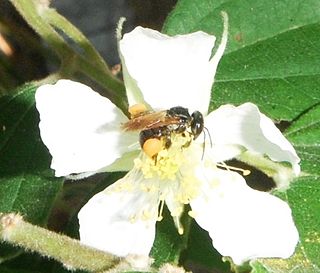
Scaptotrigona mexicana is a species of stingless bee that lives throughout Mexico and is part of the Meliponini tribe. This species is sometimes termed "Pisil Nekmej" and is extensively studied for its medicinal purposes. This species is considered common and abundant throughout Mexico and it has been noted to thrive in tropical environments.
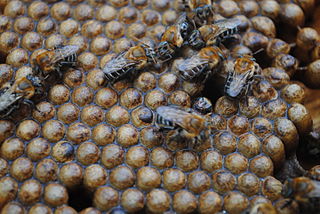
Melipona scutellaris is a eusocial stingless bee species of the order Hymenoptera and the genus Melipona. It is considered to be the reared Melipona species with the largest distribution in the North and Northeast regions of Brazil, with records from Rio Grande do Norte down to Bahia. Its common name, Uruçu, comes from the Tupi "eiru su", which in this indigenous language means "big bee". Their honey is highly desirable and the materials they create for nests have been proven to be a promising source of antibiofilm agents and to present selectivity against human cancer cell lines at low concentrations compared to normal cells.